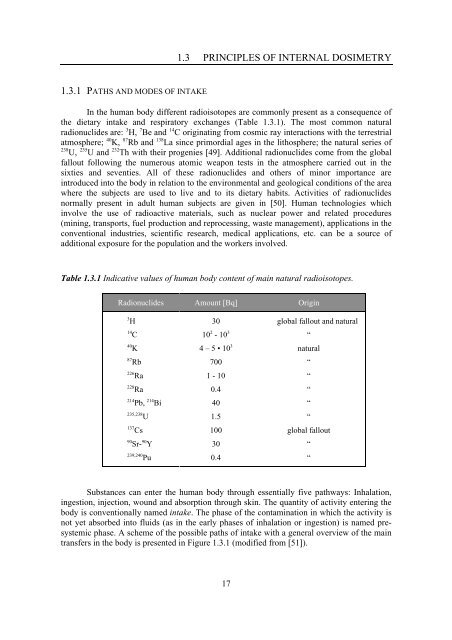Plutonium Biokinetics in Human Body A. Luciani - Kit-Bibliothek - FZK
Plutonium Biokinetics in Human Body A. Luciani - Kit-Bibliothek - FZK
Plutonium Biokinetics in Human Body A. Luciani - Kit-Bibliothek - FZK
You also want an ePaper? Increase the reach of your titles
YUMPU automatically turns print PDFs into web optimized ePapers that Google loves.
1.3.1 PATHS AND MODES OF INTAKE<br />
1.3 PRINCIPLES OF INTERNAL DOSIMETRY<br />
In the human body different radioisotopes are commonly present as a consequence of<br />
the dietary <strong>in</strong>take and respiratory exchanges (Table 1.3.1). The most common natural<br />
radionuclides are: 3 H, 7 Be and 14 C orig<strong>in</strong>at<strong>in</strong>g from cosmic ray <strong>in</strong>teractions with the terrestrial<br />
atmosphere; 40 K, 87 Rb and 138 La s<strong>in</strong>ce primordial ages <strong>in</strong> the lithosphere; the natural series of<br />
238 U, 235 U and 232 Th with their progenies [49]. Additional radionuclides come from the global<br />
fallout follow<strong>in</strong>g the numerous atomic weapon tests <strong>in</strong> the atmosphere carried out <strong>in</strong> the<br />
sixties and seventies. All of these radionuclides and others of m<strong>in</strong>or importance are<br />
<strong>in</strong>troduced <strong>in</strong>to the body <strong>in</strong> relation to the environmental and geological conditions of the area<br />
where the subjects are used to live and to its dietary habits. Activities of radionuclides<br />
normally present <strong>in</strong> adult human subjects are given <strong>in</strong> [50]. <strong>Human</strong> technologies which<br />
<strong>in</strong>volve the use of radioactive materials, such as nuclear power and related procedures<br />
(m<strong>in</strong><strong>in</strong>g, transports, fuel production and reprocess<strong>in</strong>g, waste management), applications <strong>in</strong> the<br />
conventional <strong>in</strong>dustries, scientific research, medical applications, etc. can be a source of<br />
additional exposure for the population and the workers <strong>in</strong>volved.<br />
Table 1.3.1 Indicative values of human body content of ma<strong>in</strong> natural radioisotopes.<br />
Radionuclides Amount [Bq] Orig<strong>in</strong><br />
3 H<br />
14 C<br />
40 K<br />
87 Rb<br />
226 Ra<br />
228 Ra<br />
214 Pb, 214 Bi<br />
235,238 U<br />
137 Cs<br />
90 Sr- 90 Y<br />
239,240 Pu<br />
30<br />
10 2 - 10 3<br />
4 – 5 • 10 3<br />
700<br />
1 - 10<br />
0.4<br />
40<br />
1.5<br />
100<br />
30<br />
0.4<br />
17<br />
global fallout and natural<br />
“<br />
natural<br />
“<br />
“<br />
“<br />
“<br />
“<br />
global fallout<br />
Substances can enter the human body through essentially five pathways: Inhalation,<br />
<strong>in</strong>gestion, <strong>in</strong>jection, wound and absorption through sk<strong>in</strong>. The quantity of activity enter<strong>in</strong>g the<br />
body is conventionally named <strong>in</strong>take. The phase of the contam<strong>in</strong>ation <strong>in</strong> which the activity is<br />
not yet absorbed <strong>in</strong>to fluids (as <strong>in</strong> the early phases of <strong>in</strong>halation or <strong>in</strong>gestion) is named presystemic<br />
phase. A scheme of the possible paths of <strong>in</strong>take with a general overview of the ma<strong>in</strong><br />
transfers <strong>in</strong> the body is presented <strong>in</strong> Figure 1.3.1 (modified from [51]).<br />
“<br />
“












![{A1[]Sp - Bibliothek](https://img.yumpu.com/21908054/1/184x260/a1sp-bibliothek.jpg?quality=85)




